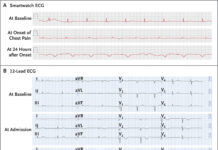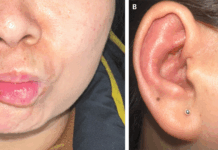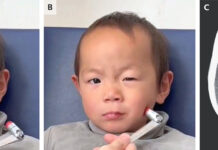Case Presentation
A 45-year-old woman from Arabia had a history of well-managed hypertension and was taking Co-Diovan 160 12.5 mg (Valsartan hydrochlorothiazide). She sought medical attention due to concerns about abdominal laxity. Upon physical examination, her abdominal laxity, diversion of recti, and upper back lipodystrophy were noted. The patient received counseling on undergoing lipoabdominoplasty, back liposuction, and gluteal lipofilling.
The medical procedure was performed under general anesthesia, and the patient’s vital signs remained stable and within normal ranges. Throughout both the procedure and the initial recovery period. Power-assisted liposuction (PAL) utilizing MicroAire (Charlottesville, Va.) and ultrasound-assisted liposuction (UAL) using VASERlipo were employed. Infiltration was carried out with size 4 diameter cannulas (Evamatic, by Euromi) using the super-wet technique.
The surgical process required the patient to be in a supine position for lipoabdominoplasty, which included liposuction of the flank and waist. Longitudinal and oblique transverse plication techniques were applied to enhance the definition of the waist. Subsequently, the patient was repositioned to a prone position for the completion of back and lateral gluteal depression liposuction. Gluteal lipo filling involved local infiltration using syringes along the incision sites, employing size 4 cannulas. Postoperatively, a pressure garment was applied without any noteworthy incidents during the approximately 6-hour procedure.
Venous thromboembolism (VTE) prophylaxis measures included adequate hydration, early ambulation, elastic stockings, and chemoprophylaxis with low-molecular-weight heparins (LMWHs). Enoxaparin 40 IU, subcutaneous, is administered 8 hours after the procedure and continued for 4 days. The patient smoothly recovered from anaesthesia, maintained room air saturation, and was transferred to her room for an overnight stay.
Post-surgery
On the first postoperative day, the patient experienced chest pain. This prompted the release of the pressure garment and the administration of painkillers. Symptoms temporarily improved but reoccurred four hours later, accompanied by tachypnea (respiratory rate: 28) and tachycardia (pulse rate: 120 bpm). Oxygen saturation remained stable in room air. Auscultation revealed diminished air entry on her left side, leading to an immediate chest X-ray and electrocardiogram (ECG). Both of these were unremarkable, except for sinus tachycardia. A computed tomography scan identified a left-sided pneumothorax. This led to an urgent thoracic surgery consultation and the insertion of a chest tube. The patient reported immediate relief of symptoms, and vital signs returned to normal.
The patient was mobilized early, engaged in regular respiratory exercises using an incentive spirometer, and performed cough exercises to aid chest expansion. By day 3, the air leak had ceased, and the chest tube was secured by thoracic surgery. It was removed 24 hours later. The patient experienced a relatively smooth recovery without additional complications.
Liposuction: Discussion
Liposuction stands out as the most frequently sought-after cosmetic procedure, often performed on an outpatient basis with the convenience of local anaesthesia at cosmetic centres. Over time, advancements in its utilization and development have enhanced the safety and simplicity of the procedure. Despite these improvements, it is crucial to recognize that liposuction is not entirely without risks. The complications associated with it tend to be underestimated and underreported by both patients and caregivers. Consequently, there exists a substantial body of literature detailing these complications, emphasizing the need for heightened awareness and the implementation of more stringent regulations.
A noteworthy concern is the reported mortality rate, standing at 19–20 per 100,000, surpassing the mortality rate documented for motor vehicle accidents (16 per 100,000). While pneumothorax is acknowledged as a rare complication of liposuction, its exact incidence remains unknown. Identifiable risk factors for pneumothorax development in such cases include liposuction near the axilla and posterior chest, the utilization of flexible infiltration cannulas, and scarring resulting from previous liposuctions. Despite a patient presenting with pneumothorax, radiographic findings may appear unremarkable, possibly due to minimal pleural air or factors related to the patient’s position.
It is strongly recommended to explicitly include pneumothorax as a potential complication during the informed consent process. This involves utilizing a stiff > 3.5 mm infiltration cannula, minimizing positive pressure ventilation, placing a heightened emphasis on cannula tip awareness for all patients, especially those with a history of previous liposuction or existing scar tissue, exercising increased caution when operating in the axilla, and reducing changes in patient positioning during the procedure. These measures aim to foster a comprehensive understanding of potential risks, ensuring that both medical practitioners and patients are well-informed and equipped to make informed decisions regarding the liposuction procedure.
Pneumothorax After Liposuction
Pneumothorax, a frequently encountered medical condition, is defined as the presence of gas within the pleural space. In the context of plastic surgery, it is considered an infrequent complication that may arise from various surgical procedures, including breast augmentation and liposuction of the upper trunk. While pneumothorax can occur spontaneously, it can also be secondary to various factors such as infection, malignancy, or direct trauma to the lung or chest wall. In a surgical setting, iatrogenic pneumothorax is induced by intraoperative pleural tear, needle puncture during the injection of local anaesthetic, or the entry of forced air into the pleural space due to elevated pressure in the surgical pocket, leading to barotrauma.




